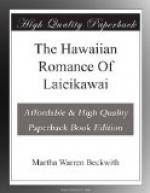Hawaiian tradition reflects these days of wandering.[4] A chief vows to wed no woman of his own group but only one fetched from “the land of good women.” An ambitious priest seeks overseas a leader of divine ancestry. A chief insulted by his superior leads his followers into exile on some foreign shore. There is exchange of culture-gifts, intermarriage, tribute, war. Romance echoes with the canoe song and the invocation to the confines of Kahiki[5]—this in spite of the fact that intercourse seems to have been long closed between this northern group and its neighbors south and east. When Cook put in first at the island of Kauai, most western of the group, perhaps guided by Spanish charts, perhaps by Tahitian navigators who had preserved the tradition of ancient voyages,[6] for hundreds of years none but chance boats had driven upon its shores.[7] But the old tales remained, fast bedded at the foundation of Hawaiian imaginative literature. As now recited they take the form of chants or of long monotonous recitals like the Laieikawai, which take on the heightened form of poetry only in dialogue or on occasions when the emotional stress requires set song. Episodes are passed along, from one hero cycle to another, localities and names vary, and a fixed form in matter of detail relieves the stretch of invention; in fact, they show exactly the same phenomena of fixing and reshaping, that all story-telling whose object is to please exhibits in transference from mouth to mouth. Nevertheless, they are jealously retentive of incident. The story-teller, generally to be found among the old people of any locality, who can relate the legends as they were handed down to him from the past is known and respected in the community. We find the same story[8] told in New Zealand and in Hawaii scarcely changed, even in name.
Footnotes to Section II, 1: Polynesian Origin of Hawaiian Romance




